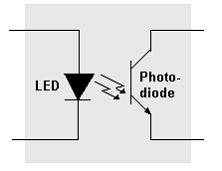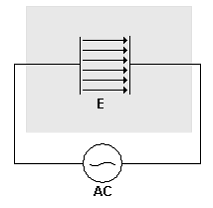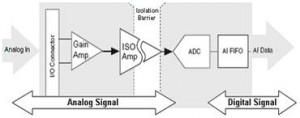The way to realize isolation
Isolation requires signal through isolation to hinder the transmission without the direct electrical connections. Commonly used non-contact signal transmission devices have light emitting diode (LED), capacitance and inductance, etc. The basic principle of this kind of device that is the most common three isolation technologies: photoelectric, capacitance and inductance coupling.
Photoelectric isolation
Optical isolation technology is a kind of passive optical device only allowing unidirectional light through, the working principle is based on the nonreciprocity of Faraday rotators. The reflected light through the optical fiber echo can be isolated well by opto-isolator. Opto-isolator mainly uses magnetic-optical crystal Faraday Effect. When both ends are added with voltage, LED will shine. Optical isolation technology used a LED and a photoelectric detection equipment, using light as a data transfer method to realize signal transmission across the isolation layer. A photoelectric detector receives this LED light, and it will then switch back to the original signal.
Optical isolation technology
Photoelectric isolation is the most commonly used method of isolation. The advantage of using photoelectric isolation is able to avoid electric and magnetic field noise. And fault is the transmission speed is limited by LED conversion speed, high power scattering and LED wear.
Capacitance isolation
Capacitance isolation is based on the charge connected in capacitance board to produce gathered the potential changes. The change can be measured from isolated obstruction; it is related to the signal size.
One advantage of capacitance isolation technology is the resistance ability to the magnetic noise interference. Compared with optical isolation technology, capacitance isolation can support higher data transfer rate, because the LEDs don’t need switch operation. Due to the capacitance isolation involved in the use of data transmission electric field, so it is vulnerable to external electric field of interference.
Inductance coupling isolation
In the early nineteenth century, the Danish physicist Hans Oersted found that when the current through the coil, it can produce the magnetic field. And later, it can win an induced current close to the magnetic coil which produces changes. Another induction coil voltage and current size depends on the first coil of alternating current. This phenomenon is called the mutual inductance; it is the basic principle of inductance coupling.
Inductance coupling uses a pair of insulating layer with coil. The insulation layer isolated signal transmission. Inductance isolation provided similar high speed transmission of capacitance technology. But because inductively coupled transmission signal to involve the magnetic field, so it is vulnerable to external magnetic field interference.



